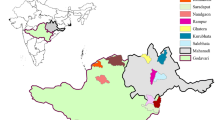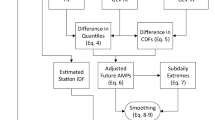Abstract
The design storm approach, where the subject criterion variable is evaluated by using a synthetic storm pattern composed of identical return frequencies of storm pattern input, is shown to be an effective approximation to a considerably more complex probabilistic model. The single area unit hydrograph technique is shown to be an accurate mathematical model of a highly discretized catchment with linear routing for channel flow approximation, and effective rainfalls in subareas which are linear with respect to effective rainfall output for a selected “loss” function. The use of a simple “loss” function which directly equates to the distribution of rainfall depth-duration statistics (such as a constant fraction of rainfall, or a ϕ-index model) is shown to allow the pooling of data and thereby provide a higher level of statistical significance (in estimating T-year outputs for a hydrologic criterion variable) than use of an arbitrary “loss” function. The above design storm unit hydrograph approach is shown to provide the T-year estimate of a criterion variable when using rainfall data to estimate runoff.
Similar content being viewed by others
Abbreviations
- A ω :
-
peak value (demand) of A for storm event ω
- A δω :
-
demand duringI δ based on functionF
- \(\alpha _{k_1 } \) :
-
timing offsets for channel link #1 used in the linear routing technique
- \(\alpha _{k_1 }^0 \) :
-
\(\alpha _{k_1 } \) corresponding to storm class\(\Omega _{\omega _0 } \)
- λ i jn :
-
effective rainfall proportion factors for subareaR j and stormi
- θ i jn :
-
effective rainfall timing offsets for subareaR j and stormi
- φ i j (s):
-
subarea unit hydrograph (UH) for subareaR j and stormi
- Ω:
-
probabilities space of all storms
- P :
-
probability measure on Ω
- \(\Omega _{\omega _0 } \) :
-
specific storm class
- ηi(·):
-
transfer function between measured effective rainfall and measured runoff, for stormi, using a Volterra integral model structure
- ηω(·):
-
transfer function for annual storm ω, usingF
- \(\eta _\omega ^{\omega _0 } ( \cdot )\) :
-
the restriction of ηω to the probability space\(\Omega _{\omega _0 } \)
- ηω(·):
-
ψω(·)W ω, ψω(·) a unit hydrograph
- a k 1 :
-
proportion factors for linear routing technique, used for channel link #1
- e ig (t) :
-
effective rainfall measured at the rain gage site, for stormi
- eg ω(·):
-
effective rainfall at the rain gage site for storm ω
- e ij (t) :
-
subareaR j effective rainfall for stormi
- e ω(·):
-
synthetic storm pattern input, usingF, for storm ω
- e δω (t) :
-
e ω (t) inI δ; 0, otherwise
- \(\bar e_\omega ^\delta (t)\) :
-
\(\bar I(e_\omega ^\delta ( \cdot ))\) fort inI δ; 0, otherwise
- \(\bar e_T^\delta \) :
-
T-year return frequency value of\(\bar I(e_\omega ^\delta ( \cdot ))\)
- Δe δω (t):
-
e δω (t)−\(\bar e_\omega ^\delta (t)\) inI δ, 0 outsideI δ
- \(E_{\omega _0 }^\delta ( \cdot )\) :
-
\(E(\Delta e_\omega ^\delta ( \cdot )|\bar I(e_{\omega _0 }^\delta ( \cdot )))\)
- ε δω :
-
Δe δω (·)−E δω (·)
- F :
-
effective rainfall function
- \(\bar I(e_\omega ^\delta ( \cdot ))\) :
-
mean value ofe δω (·) inI δ
- I δ :
-
peak storm pattern input time interval of duration δ; also, the operation of locating the peak duration δ of storm pattern input
- I(t) :
-
inflow hydrograph for linear routing
- M :
-
rainfall-runoff model
- 0(t) :
-
outflow hydrograph for linear routing
- \(\bar P_\delta \) :
-
mean precipitation for peak duration δ
- \(\bar P_T^\delta \) :
-
T-year return frequency value of\(\bar P_\delta \)
- P ω(·):
-
rainfall measured at the rain gage site, for storm ω
- P i (t) :
-
yeari annual storm precipitation
- Q ig (t) :
-
runoff hydrograph, for stormi, measured at the stream gage
- Q i (t) :
-
yeari annual storm runoff
- Q ω(·):
-
runoff hydrograph for storm ω
- Q δω (·):
-
runoff hydrograph resulting from peak time interval δ ofe ω(·)
- Q im (t) :
-
m-subarea link-node model output for stormi
- Q pT :
-
T-year return frequency peak flow rate
- q ij (t) :
-
runoff hydrograph from subareaR j, for stormi
- R :
-
total catchment
- R j :
-
subarea inR
- S T (t) :
-
T-year design pattern input
- S δ T (·) :
-
T-year design storm for peak time interval δ
- s,t :
-
temporal & integration variables
- x i :
-
annual storm event for yeari
- <k>:
-
vector notation for subscript sequence,k
References
Beard, L.; Chang, S. 1979: Urbanization impact on stream flow. J. of the Hydraulic Div., ASCE, 647–659
Doyle, W.H.; Shearman, J.O.; Stiltner, G.J.; Krug, W.R. 1983; A digital model for streamflow routing by convolution methods. U.S. Geological Survey, Water-Resources Investigations Report 83-4160
Hromadka II, T.V.; McCuen, R.H. 1986: Orange County hydrology manual. OCEMA, Santa Ana, California
Huff, F.A. 1967: Time distribution of rainfall in heavy storms. Water Resour. Res. 3, 1007–1019
Huff, F.A. 1970: Spatial distribution of rainfall rates. Water Resour. Res. 6, 254–260
Loague, K.; Freeze, R. 1985: A comparison of rainfall-runoff modeling techniques on small upland catchments. Water Resour. Res. 21, 229–248
Mikusinski, J. 1983: Operational calculus, Vol. 1, 2nd edition, Pergamon Press
Nash, J.; Sutcliffe, J. 1970: River flow forecasting through conceptual models, Part I — A discussion of principles. J. of Hydrology 10, 282–290
Pierrehumbert, C.L. 1974: Point rainfall intensity-frequency-duration data capital cities. Dept. of Science, Bureau of Meteorology, Bull. 49, Australian Gov. Pub. Services, Canberra
Schilling, W.; Fuchs, L. 1986: Errors in stormwater modeling — A quantitative assessment. J. of Hydraulic Eng. ASCE 112, 111–117
Troutman, B. 1982: An analysis of input in precipitation — runoff models using regression with errors in the independent variables. Water Resour. Res. 18, 947–964
U.S. Army Corps of Engineers, HEC, 1982: Hydrologic analysis of ungaged watersheds using HEC-1. Training Document No. 15
Author information
Authors and Affiliations
Rights and permissions
About this article
Cite this article
Hromadka, T.V., Whitley, R.J. The design storm concept in flood control design and planning. Stochastic Hydrol Hydraul 2, 213–239 (1988). https://doi.org/10.1007/BF01550843
Accepted:
Issue Date:
DOI: https://doi.org/10.1007/BF01550843




